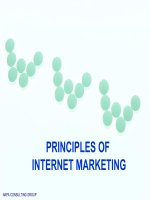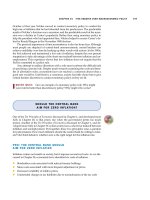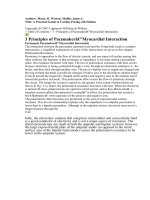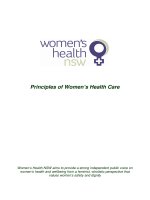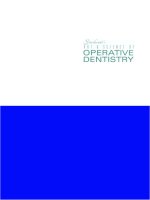Principles of Operative Dentistry doc
Bạn đang xem bản rút gọn của tài liệu. Xem và tải ngay bản đầy đủ của tài liệu tại đây (3.89 MB, 193 trang )
Principles of
OPERATIVE
DENTISTRY
AJE Qualtrough, JD Satterthwaite
LA Morrow, PA Brunton
Qualtrough Cvr01b.qxd 19/5/04 6:23 am Page 1
Principles of
Operative
Dentistry
A.J.E. Qualtrough
J.D. Satterthwaite
L.A. Morrow
P.A. Brunton
POOA01 02/18/2005 04:32PM Page i
© 2005 by A.J.E. Qualtrough, J.D. Satterthwaite, L.A. Morrow
and P.A. Brunton
Blackwell Munksgaard, a Blackwell Publishing company
Editorial Offices:
Blackwell Publishing Ltd, 9600 Garsington Road, Oxford OX4 2DQ, UK
Tel: +44 (0)1865 776868
Blackwell Publishing Professional, 2121 State Avenue, Ames, Iowa 50014-8300,
USA
Tel: +1 515 292 0140
Blackwell Publishing Asia Pty Ltd, 550 Swanston Street, Carlton, Victoria 3053,
Australia
Tel: +61 (0)3 8359 1011
The right of the Author to be identified as the Author of this Work has been
asserted in accordance with the Copyright, Designs and Patents Act 1988.
All rights reserved. No part of this publication may be reproduced, stored in a
retrieval system, or transmitted, in any form or by any means, electronic,
mechanical, photocopying, recording or otherwise, except as permitted
by the UK Copyright, Designs and Patents Act 1988, without the prior permission
of the publisher.
First published 2005 by Blackwell Munksgaard
Library of Congress Cataloging-in-Publication Data
Principles of operative dentistry / A.J.E. Qualtrough [et al.].
p. ; cm.
Includes bibliographical references and index.
ISBN-13: 978-1-4051-1821-7 (pbk. : alk. paper)
ISBN-10: 1-4051-1821-0 (pbk. : alk. paper)
1. Dentistry, Operative. 2. Endodontics. 3. Evidence-based dentistry.
I. Qualtrough, A. J. E.
[DNLM: 1. Dentistry, Operative–methods. 2. Endodontics–methods.
3. Evidence-Based Medicine. WU 300 P9575 2005]
RK501.P854 2005
617.6′05–dc22
2004026345
ISBN-13: 978-1-4051-1821-7
ISBN-10: 1-4051-1821-0
A catalogue record for this title is available from the British Library
Set in 10/13 pt Palatino
by Graphicraft Limited, Hong Kong
Printed and bound in Great Britain
by TJ International, Padstow, Cornwall
The publisher’s policy is to use permanent paper from mills that operate
a sustainable forestry policy, and which has been manufactured from
pulp processed using acid-free and elementary chlorine-free practices.
Furthermore, the publisher ensures that the text paper and cover board
used have met acceptable environmental accreditation standards.
For further information on Blackwell Munksgaard, visit our website:
www.dentistry.blackwellmunksgaard.com
POOA01 02/18/2005 04:32PM Page ii
Contents
Foreword v
Preface vii
Contributors ix
Acknowledgements x
1 Basic principles 1
Ergonomics in dentistry 1
Examination of the dentition – occlusion 8
Examination of the dentition – charting 11
Dental caries 14
Moisture control 19
2 Principles of direct intervention 27
Preservative management 27
Principles of operative intervention 27
Alternative preparation methods 33
Pulp protection 36
Supplementary retention for direct restorations 43
3 Principles of endodontics 51
Introduction 51
Diagnosis and assessment 52
Endodontic imaging 54
Access cavities 56
Endodontic instruments 62
Cleaning and shaping 68
Inter-appointment medicaments 73
Obturation (root filling) 75
4 Endodontics – further considerations 81
Trauma 81
Perio-endo connections 86
Elective endodontics 90
Restoration of the root-filled tooth 93
iii
POOA01 02/18/2005 04:32PM Page iii
iv Contents
5 Principles of indirect restoration 107
Introduction and indications 107
Core restorations 111
Principles of preparation for indirect restorations 115
Summary 127
6 Indirect restorations – further considerations 129
Material type 129
Intra/extra-coronal restoration 133
Partial coverage restorations 133
Temporisation 134
Impression taking 139
Methods of construction 143
Limited resistance and retention 145
Creation of interocclusal space 147
Limitations of indirect restorations 150
7 Maintenance of the restored dentition 153
Maintenance 153
Failure 154
Replacement and repair of restorations 156
8 Evidence based practice 161
Introduction – what is evidence based practice? 161
Identifying and defining relevant questions 162
Identifying evidence 163
Appraisal of research literature 167
Implementation of research evidence and evaluation
of its application 170
Conclusion 171
Index 173
POOA01 02/18/2005 04:32PM Page iv
Foreword
Operative dentistry forms the central part of dentistry as practised in
primary care. It occupies the majority of a dentist’s working life and
is a key component of restorative dentistry. It is unfortunate that the
academic discipline of operative dentistry has become less clearly
identifiable within many dental schools. The Operative Dentistry or
Conservative Dentistry Department is now often part of a larger
department of Restorative Dentistry and can less easily be seen as a
discipline in its own right. Indeed, operative dentistry is not recog-
nised as a specialty either in the United Kingdom or the United States
which, given its central position in the delivery of oral healthcare to
patients, is unfortunate.
The subject of operative dentistry continues to evolve rapidly as the
improved understanding of the aetiology and prevention of the com-
mon dental diseases is linked with advances in restorative techniques
and materials. The effective practice of operative dentistry requires
not only excellent manual skills but an understanding of both the
disease processes affecting teeth and the properties of the materials
available for their restoration.
In view of the seemingly diminished status of operative dentistry, it
is all the more pleasing that four well-known, younger academic and
hospital-based colleagues have collaborated to create this new book,
Principles of Operative Dentistry. It is directed primarily towards the
dental undergraduate but will benefit the primary care dentist as well
as those engaged in more formal postgraduate study. Many operative
textbooks place an emphasis on technique but sometimes do not
describe adequately the thinking that underpins both the operative
procedures and the overall management of the patient. The authors
are to be commended for having taken the logical approach of exam-
ining the reasons for the procedures and techniques available in oper-
ative dentistry. There is wide coverage of the subject, including the
restoration of cavities in teeth, management of the dental pulp, the
various types of indirect restorations and the management of failed
restorations.
v
POOA01 02/18/2005 04:32PM Page v
vi Foreword
The clear presentation and easy style of the book encourages the
reader, whilst the arguments for and against particular techniques are
supported by reference to the dental literature. The latter is of increas-
ing importance as the demand for evidence-based dentistry gains
momentum. The inclusion of a chapter explaining evidence-based
practice and how information can be found is particularly welcome.
This book provides a wealth of information which is a distillation of
the knowledge and experience of the authors. It is also a book for the
reader to enjoy and it is to be hoped that it will stimulate a life-long
interest in the principles and practice of operative dentistry.
Richard Ibbetson
Director, Edinburgh Postgraduate Dental Institute
and Professor of Primary Dental Care, University of Edinburgh
POOA01 02/18/2005 04:32PM Page vi
Preface
Operative dentistry is a significant part of clinical dentistry, with
practitioners in the UK spending more than 60% of their time placing
and replacing direct restorations. In tandem with this many root canal
treatments are carried out and increasingly more indirect restorations
are placed. All practitioners whatever their discipline will remember
developing their manual skills while engaged in these procedures
during their student days.
This book is about the theoretical concepts that underpin clinical
practice in the areas of operative dentistry and endodontology and it
is primarily directed at clinical dental students and professionals
complementary to dentistry. The aim of the text is to provide students
with the knowledge required while they are developing the necessary
clinical skills and attitudes in their undergraduate training in operative
dentistry and endodontology. It is specifically designed to be read in
conjunction with pre-clinical and clinical training.
Each chapter addresses various aspects of the subject and there is
directed additional reading in the form of selected relevant refer-
ences. Specific tips will be highlighted throughout the text and there
is information about the application of dental materials, although
readers are referred to specific texts on dental materials for further
information.
After reading this book the reader should be able to:
• Sit properly while operating and be able to organise their operating
environment effectively
• Chart teeth
• Understand the basics of cariology, specifically diagnose caries
more effectively especially in its early stages
• Prepare teeth to include supplementary retention if indicated
clinically
• Understand modern pulp protection regimes
• Select and place the correct restorative material
• Understand when endodontic treatment is indicated
• Access the pulp chamber and root canal systems of teeth
vii
POOA01 02/18/2005 04:32PM Page vii
viii Preface
• Effectively clean, shape and obturate the root canal system
• Restore endodontically treated teeth
• Determine when indirect restorations are indicated
• Prepare teeth appropriately for indirect restorations
• Manage soft tissues and use impression materials
• Place a variety of temporary restorations
• Select restorations suitable for repair and refurbishment procedures
Increasingly the evidence base for dentistry is being challenged
and it is often said that only 15% of the whole of dentistry is evidence
based. The book therefore concludes with a chapter on evidence
based dentistry, as the practitioners of the future must have a working
knowledge of the principles of evidence based care.
POOA01 02/18/2005 04:32PM Page viii
ix
Contributors
Julian D. Satterthwaite BDS MSc MFDS FDSRCS(Eng)
Lecturer in Restorative Dentistry, School of Dentistry, University of
Manchester, UK
Leean A. Morrow BDS(Hons) MPhil FDS FDS(Rest Dent) RCS(Eng)
Consultant in Restorative Dentistry, The Leeds Teaching Hospitals
NHS Trust, Leeds, UK
Alison J.E. Qualtrough BChD MSc PhD FDS MRDRCS(Edin)
Senior Lecturer/Honorary Consultant in Restorative Dentistry,
School of Dentistry, University of Manchester, UK
Paul A. Brunton BChD MSc PhD FDS FDS(Rest Dent) RCS(Eng)
Professor/Honorary Consultant in Restorative Dentistry, Leeds
Dental Institute, University of Leeds, UK
Evidence based care
Helen Worthington MSc PhD
Professor of Evidence Based Care/Coordinating Editor of Cochrane
Oral Health Group, School of Dentistry, University of Manchester,
UK
Anne-Marie Glenny MMedSci
Lecturer in Evidence Based Oral Health Care, School of Dentistry,
University of Manchester, UK
Ergonomics
W. Alan Hopwood BDS MDS
Clinical Teacher in Restorative Dentistry, School of Dentistry, Univer-
sity of Manchester, UK
Radiology
Keith Horner BChD MSc PhD FDSRCPS(Glasg) FRCR DDR
Professor of Oral and Maxillofacial Imaging/Honorary Consultant in
Dental and Maxillofacial Radiology, School of Dentistry, University
of Manchester, UK
Illustrations
Raymond Evans MAA RMIP, Medical Illustrator
POOA01 02/18/2005 04:32PM Page ix
x
Acknowledgements
We would like to express our gratitude to all those individuals
who have been formative to the ethos of teaching at the School
of Dentistry, University of Manchester. This philosophy was the
stimulus for the production of this text. Although many individuals
have been involved, we are particularly grateful to Professor Nairn
Wilson and Drs John Lilley and Shaun Whitehead.
In addition, we would like to express our thanks to Mr Clive Atack,
Chief Photographer, Unit of Medical Illustration, School of Dentistry,
University of Manchester, for Figs 1.2 to 1.5.
POOA01 02/18/2005 04:32PM Page x
1
1
Basic principles
ERGONOMICS IN DENTISTRY
Ergonomics is defined as ‘the study of man in relation to his working
environment: the adaptation of machines and general conditions to fit
the individual so that he may work at maximum efficiency’.
The application of these principles concerns every aspect of design
within the building and streamlining of procedure. Within the surgery,
the contemporary dental unit is a masterpiece of design incorporating
as many ergonomic features as possible to enable the operator, dental
nurse and patient to experience the minimum of stress and fatigue. It
is evident, furthermore, that this environment must facilitate a high
standard of dental treatment as clinical techniques become ever more
complex and exacting.
This transformation began with the general adoption of a comfort-
able, supported and seated position for the operator and the consequent
supine positioning of the patient. However, the necessary changes
in posture and working procedures were largely overlooked and,
despite the convincing work and publication of Paul
1
, it would seem
that many dentists persist in working in inefficient, distorted postures
that must frequently lead to excessive fatigue if not skeletal damage.
The operator’s chair
This should be fully adjustable and mobile, provide a broad, pre-
ferably anatomically contoured seat and give support in the lumbar
region. It should be adjusted in height to suit each individual operator
in order to distribute the weight equally between the thighs and feet.
The dental nurse chair differs only, but importantly, in that it must
adjust to at least a 10 cm increase in height and provide a correspond-
ing ‘bar stool’ type rim rest for the feet.
POOC01 02/18/2005 04:32PM Page 1
Operator and nurse positions
The dentist will normally work within a range from the 12 o’clock to
the 9 o’clock position relative to the patient’s head. However, most
operative procedures are completed from, at, or near, the 12 o’clock
position. The dental nurse will normally remain in a fixed position at
4 o’clock (Fig. 1.1) but at a considerably higher position in order to
look down or forward to the mouth. This height not only facilitates
the different tasks, but enables the nurse to visualise the back of the
mouth and remove any accumulation of debris or water.
Operator’s vision
There can be no doubt that any tooth is best visualised by direct vision
(Fig. 1.2). However, the nature of operative dentistry demands that,
whenever possible, the line of vision is perpendicular to the tooth
surface. Clearly, those surfaces inaccessible by direct vision must
be visualised indirectly through a mirror (Fig. 1.3). Nevertheless, it
remains important, however difficult, to position the mirror and
attempt a near perpendicular view. Magnification of the working area
provides a major advantage in both the reduction of eye strain and the
promotion of high standards.
2 Chapter 1
Fig. 1.1 Position of operator relative to chair.
POOC01 02/18/2005 04:32PM Page 2
Patient position
Adoption of the supine patient position by most dental practitioners
has focused attention on the optimal position of the patient’s head
in relation to the seated operator. Paul
1
compares this relationship in
Basic principles 3
Fig. 1.2 Direct vision.
Fig. 1.3 Visualisation in mirror.
POOC01 02/18/2005 04:32PM Page 3
dentistry to any other precision activity by a seated operator and
describes the ‘home position’ in which the objective is raised to the
mid-sternal position and the head tilted forward to observe the
fingers. Most dentists will gradually adopt this position by trial and
error and indeed many will programme the dental chair to return
and permit this situation for every patient (Fig. 1.4).
Observation of a large number of operators over many years
reveals, however, that for some procedures, with a supine patient, a
large proportion will adopt distinctly uncomfortable, distorted and
fatiguing positions. Furthermore, it would appear that the reasons for
this distortion are principally related to:
• An attempt to adopt a direct visual approach, despite severe pos-
tural distortion, when an indirect approach is more appropriate.
• The natural, almost in-built attempt to visualise the tooth surface
via the perpendicular approach, without appropriate positioning
and rotation of the patient’s head.
The former situation should be corrected by training, practice
and a disciplined procedure but the latter can only be corrected by
a different patient posture provided by a modified chair position.
Specifically, the difficulty lies in viewing the lower posterior teeth
in the fully supine patient. In this situation, it can undoubtedly be an
4 Chapter 1
Fig. 1.4 The home position.
POOC01 02/18/2005 04:32PM Page 4
advantage to position the chair base considerably lower but tilted
forward to approximately 40° from the waist to return the patient’s
head to the ‘home’ position (Fig. 1.5). The correctly seated operator
will have a visual approach near perpendicular to the posterior
surfaces.
Illumination
There can be no better illustration of the recent transformation in
working procedures than in the area of illumination. Indeed, it is a
tribute to the dentists of the past that they accomplished such complex
tasks with little other than an anglepoise lamp.
The enormous advantage of halogen unit lamps is self-evident. No
doubt the future will prove even brighter with light emitting diodes
(LEDs). In addition, the increasing use of fibre-optic handpieces
ensures constantly focused illumination of the working area and
eliminates the need to use the mirror as an additional aid to reflect
unit-sourced light. Despite these advances, when using light-sensitive
materials such as resin composites, it remains necessary to work
with low light levels as high intensity light will lead to premature
polymerisation of the material, thus preventing manipulation.
Basic principles 5
Fig. 1.5 The home position for lower teeth.
POOC01 02/18/2005 04:32PM Page 5
Magnification is a further major step forward in enhancing the
vision of the work surface and the use of telescopic loupes, sometimes
fitted with their own light source, is understandably commonplace.
Four-handed dentistry
The term four-handed dentistry is now rooted in professional termino-
logy but implies no more than the importance of team effort. The
dental team normally comprises the operator and nurse (four hands),
but it is not uncommon for an additional nurse to make six.
Principles of four-handed dentistry
There are many ways in which the dental team can work efficiently,
along ergonomic principles. Nevertheless, the underlying principles
are:
• Rationalisation and standardisation. The repetitive nature of so much
in dentistry offers the ideal opportunity to ration the immediate
supply of instruments to those most commonly used and, also, to
standardise technique so that, with practice, considerably greater
efficiency will be achieved.
• Delegation. Delegation is the transfer of any task to a person who is
both qualified and capable. This remains an area in which many
dentists fail to take full advantage of the skills of the dental nurse.
• Anticipation. The experienced dental nurse will quickly learn the
individual methods of the operator and begin to anticipate almost
every situation. As a member of a regular dental team, rather than
one based on rotational duty, the advantages can be significant.
• Safety. The focus and control achieved in all the various approaches
to four-handed dentistry is undoubtedly matched by improved
safety for both patient and operator. However, while there has been
understandable concern that a supine patient may be at greater risk
of ingestion or inhalation of foreign matter, it has been shown that,
in this position, the tongue rests against the soft palate to provide a
seal
2
. Nevertheless, some posterior pooling of fluid will inevitably
occur and the responsibility of both nurse and operator in the
control and removal of this accumulation cannot be overstated.
In procedures carrying higher risk, such as endodontics, the
total protection of the airway utilising rubber dam is self-evident.
6 Chapter 1
POOC01 02/18/2005 04:32PM Page 6
However, it is essential that no dental procedure should take place
without appropriate airway protection, irrespective of patient
position.
All patients, and indeed members of the dental team, should be
provided with protective eyewear and for the supine patient, no
transfer of materials or instruments should occur over the face.
• Methods. The concept of four-handed, ergonomic dentistry is open
to varied individual approach and has been described in detail
by Paul
1
. However, the underlying principle demands that all
delivery, discard and transfer takes place in the area of safety and
convenience around and below the chin – the so-called ‘transfer
zone’ (Fig. 1.6). This practice demands maximal delegation to the
dental nurse and requires concerted effort and understanding.
However, the advantage to the operator, and hence the patient, of
an undistracted focus on the tooth is considerable.
A comparison is with that of the general surgeon awaiting the
appropriate instrument, correctly positioned for immediate grasp
and use. The dentist’s hands should therefore remain whenever
possible in the transfer zone, instruments and materials should be
asked for, not looked for, and be received to enable correct grasp
with no risk of injury.
Basic principles 7
Fig. 1.6 Exchange of instruments in the transfer zone.
POOC01 02/18/2005 04:32PM Page 7
If both hands are free, instrument transfer is simple but more
commonly the task must be completed in one hand. This method
of instrument retrieval by the fourth finger, rotation of the wrist,
and supply from thumb to first fingers is easily mastered and is
undoubtedly efficient.
Therefore, it is clear that when due attention is paid to basic proce-
dural aspects and organisation, the clinical scenario is efficient, effective,
enjoyable and professional. On the other hand, without such discipline,
there is the potential for inefficiency, lower standards and a lost opp-
ortunity to maximise the potential for a fulfilled professional career.
EXAMINATION OF THE DENTITION – OCCLUSION
Before examining any individual teeth that may require restoration,
it is important to look at all the teeth, how they meet and how they
move against each other. These relationships are collectively termed
the occlusion. The occlusion will affect not only the functional load
to which a tooth or restoration is subjected, but can also influence
the shape and form of a restoration. For example, if a molar tooth is
separated by a considerable amount from its antagonist tooth during
movement of the mandible, than there is plenty of height for cusps to
be carved into a restoration. Conversely, if restoring a tooth that rubs
against its antagonist during movement of the mandible, then cusps
are likely to be more shallow, and care must be taken that excess load
is not placed onto the restoration during function.
Preoperative examination of the occlusion is essential. Note must
be taken of existing relationships, both static and dynamic/excursive.
The use of thin articulating paper to mark the teeth and identify con-
tacts is required. Differing colours may be used for static and dynamic
contacts. Study models, mounted with a face bow record on an articu-
lator, may also prove to be useful, especially if multiple units or units
involving guiding surfaces are to be restored. An explanation of
occlusal terminology and relationships follows.
Intercuspal position (ICP)
The intercuspal position is the static position of maximum inter-
digitation of the cusps of the teeth, where the mandible is in its most
closed position: it is also an habitual position. This position may be
easily reproducible and identified on study models as ‘best fit’ (e.g. in
8 Chapter 1
POOC01 02/18/2005 04:32PM Page 8
a fully dentate patient) or may be difficult to identify and perhaps
variable (e.g. in a patient with tooth wear). It is a changeable and unstable
position as it will change as the teeth change throughout the lifetime
of the patient. It is also called maximum interdigitation position (MIP)
and centric occlusion (CO).
Retruded axis position (RAP)
The retruded axis position is not a fixed point, but an ‘arc’ defined by
the movement of the mandible when retruded, at which only hinge
movements are possible. It is also called terminal hinge axis or centric
relation (CR). RAP is also defined anatomically as the position where
the condyles are most superiorly placed within the glenoid fossae,
with the articular discs in a close-packed position. It is a relaxed rela-
tionship and is the only true reproducible position.
Retruded contact position (RCP)
The retruded contact position is the point of first contact (between a
maxillary and mandibular tooth) when closing on the retruded arc of
closure (see RAP above). The movement from the RCP to ICP is
termed a slide, and note should be taken of the magnitude of this slide
as well as direction (i.e. vertical, horizontal – anterior to posterior and
lateral components).
Excursion/excursive movements
Excursion relates to the dynamic movements of the mandible, as in:
• Lateral excursion – to the side (left or right)
• Protrusion – forward/anterior movement of the mandible
• Retrusion – backward/posterior movement of the mandible
Working side
The working side is the side to which the mandible moves when mak-
ing a lateral excursive movement.
Non-working side
The non-working side is the opposite side from that to which the
mandible moves when making a lateral excursive movement.
Sometimes called the balancing or orbiting side.
Basic principles 9
POOC01 02/18/2005 04:32PM Page 9
Anterior/posterior determinants and guidance
Determinants of mandibular movements are the influences deter-
mining the envelope of possible movements of the mandible. These
influences may be:
• Posterior determinants (i.e. the temporomandibular joints and
anatomical structures associated with them, also termed condylar
guidance/posterior guidance).
• Anterior determinants (i.e. the teeth).
The tooth surfaces that are in contact during an excursive move-
ment are said to ‘guide’ movement of the mandible. The type of
guidance may be divided as below, the divisions broadly describing
the teeth that provide the guiding surface:
• Anterior guidance – the tooth surfaces that are in contact during
a protrusive excursion. This is normally the incisor teeth, and
hence is then termed incisal guidance: in some cases (for example
an occlusion with an anterior open bite) it may actually be the
posterior occlusal tooth surfaces that provide the anterior
guidance.
• Canine guidance – when a lateral excursion is made, the canines on
the working side are the only teeth to make contact.
• Group function – when a lateral excursion is made, multiple pairs of
teeth on the working side make contact.
Tooth contacts during dynamic excursive movements that do not
provide a smooth guidance, or separate guiding surfaces, may be
termed an interference.
Non-working contact
A non-working contact is a contact between a pair of tooth sur-
faces on the non-working side during an excursive movement that
does not otherwise interfere with the smooth movement of the
mandible nor cause the guiding surfaces on the working side to be
separated.
Non-working interference (NWI)
A non-working interference is a contact between a pair of tooth
surfaces on the non-working side, during an excursive movement,
that interferes with the smooth movement of the mandible and/or
10 Chapter 1
POOC01 02/18/2005 04:32PM Page 10
causes the guiding surfaces on the working side to be separated. It is
important to identify such contacts as they are thought to cause high
lateral loads on teeth and a subsequent predisposition to mechanical
failure of a restoration.
Any new restoration must be in harmony with the existing occlu-
sion if this is satisfactory. Where occlusal contacts are present that
may cause treatment difficulties or a predisposition to failure, then
steps should be taken to address this. For example, a cavity margin
might be extended to avoid a contact at the potentially weak tooth-
restoration interface or a non-working side interference reduced or
eliminated (Chapter 2). Similarly, where indirect restorations are
planned, these may be used to create a new occlusal relationship in
situations when the existing pattern is not satisfactory.
EXAMINATION OF THE DENTITION – CHARTING
A dental charting is a stylised record of the patient’s current dental
status. It is good clinical practice to record the dental status at initial
presentation and subsequent follow-up appointments. A full dental
charting should be recorded in all patients’ notes, thus forming part
of the medico-legal record. It is not necessary to map the patient’s
restorations in detail on the charting, it is sufficient to record the type
of restoration and/or cavity, not its exact dimensional extent. The
object of a dental chart is to record:
• All teeth present.
• Teeth that are absent or unerupted.
• Presence and condition of existing restorations (including partial
dentures and bridgework).
• Presence and extent of dental caries and other dental abnormalit-
ies, (e.g. non-carious tooth tissue loss, fractures, developmental
defects and discoloration).
Tooth notation
Several different systems are available for tooth reference; there are
however three systems that most practitioners should be aware of
in order to be familiar with the increasing internationalisation of
dental journals, conferences and other forms of communication. Most
systems divide the mouth into four quadrants, which are indicated
as if one is viewing the patient from the front:
Basic principles 11
POOC01 02/18/2005 04:32PM Page 11
upper right upper left
lower right lower left
Palmer system
The permanent teeth are numbered from 1 to 8, from central incisor to
third molar. Each tooth also has be identified by the quadrant, thus the
upper right first permanent molar is designated 6|, while the upper
left first permanent molar is designated |6:
Patient’s right 87654321 12345678 Patient’s left
87654321 12345678
The primary (deciduous) teeth are represented by the letters A to E,
from central incisor to second deciduous molar and also have to have a
quadrant designation e.g. the upper right deciduous central incisor is A|.
Patient’s right EDCBA ABCDE Patient’s left
EDCBA ABCDE
It is advisable to use capital letters when referring to the deciduous
dentition using the Palmer notation. If lower case letters are used,
b can look like 6, and vice versa. This is especially important when
patients are being referred for dental extractions.
Federation Dentaire Internationale (FDI) system
This system is commonly used in Europe. Each tooth is given a two-
digit number; the first digit identifies the quadrant in which the tooth
is situated and the second digit identifies the tooth in that quadrant.
In the permanent dentition, the quadrants are numbered from 1 to 4
starting with the upper right, which is quadrant 1, and continuing
round in a clockwise direction to the lower right, which is quadrant 4.
The teeth are numbered from 1 to 8 in each quadrant starting with 1
being the central incisor and continuing to 8 being the 3rd permanent
molar. The permanent dentition is:
Quadrant 1 Quadrant 2
18 17 16 15 14 13 12 11 21 22 23 24 25 26 27 28
48 47 46 45 44 43 42 41 31 32 33 34 35 36 37 38
Quadrant 4 Quadrant 3
12 Chapter 1
POOC01 02/18/2005 04:32PM Page 12
In the deciduous dentition, the quadrants are numbered from 5 to 8
starting with the upper right, which is quadrant 5, and continuing
round in a clockwise direction to the lower right, which is quadrant 8.
The teeth are numbered from 1 to 5 in each quadrant starting with
1 being the central incisor and continuing to 5 being the second
deciduous molar. The deciduous dentition is:
Quadrant 5 Quadrant 6
55 54 53 52 51 61 62 63 64 65
85 84 83 82 81 71 72 73 74 75
Quadrant 8 Quadrant 7
Universal system
This system is commonly used in America. The teeth are given
individual numbers from 1 to 32, starting with the upper right third
molar and moving clockwise round the arch to the lower right third
molar.
1 2 3 4 5 6 7 8 9 10 11 12 13 14 15 16
32 31 30 29 28 27 26 25 24 23 22 21 20 19 18 17
Surfaces of teeth
When describing a cavity or restoration, the location can be
described by the surfaces of the tooth that are involved. These are
as follows:
• Mesial: nearest to the midline of dental arch
• Distal: further from the midline of dental arch
• Labial: next to lips (anterior teeth)
• Buccal: next to cheeks (posterior teeth)
• Lingual: next to tongue (lower teeth)
• Palatal: next to palate (upper teeth)
• Incisal: cutting edge of anterior teeth
• Occlusal: chewing surface of posterior teeth
These surfaces can be represented diagrammatically as a box with five
areas, each of which represents a surface (Fig. 1.7). A series of such
boxes is used to represent all of the teeth (Fig. 1.8).
Basic principles 13
POOC01 02/18/2005 04:32PM Page 13
DENTAL CARIES
Dental caries is a disease process resulting in the demineralisation of
dental hard tissues by microbial activity. It is a readily preventable
disease and can be arrested or reversed in its early stages. The pattern
of dental caries has changed in recent years; new lesions are more
likely to develop in pits and fissures, with smooth surface lesions
becoming less common
3
.
Aetiology
Dental caries has a multifactorial aetiology; however four principle
factors are necessary for the production of a carious lesion:
• Bacteria in dental plaque
• Substrate such as a fermentable carbohydrate (dietary sugars)
• A susceptible tooth surface
• Time
14 Chapter 1
Fig. 1.7 Representation of tooth surface.
Fig. 1.8 Typical charting matrix.
POOC01 02/18/2005 04:32PM Page 14
